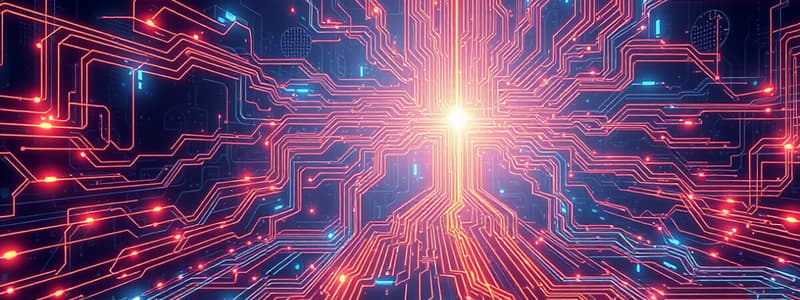Podcast
Questions and Answers
What is an electric circuit?
What is an electric circuit?
An interconnection of electrical elements linked together in a closed path so that an electric current may flow continuously.
What is charge measured in?
What is charge measured in?
Coulombs (C)
What happens to current when a conducting wire is connected to a battery?
What happens to current when a conducting wire is connected to a battery?
The negative charges are compelled to move, creating electric current.
What is the difference between Direct Current (DC) and Alternating Current (AC)?
What is the difference between Direct Current (DC) and Alternating Current (AC)?
What is the unit of electric current?
What is the unit of electric current?
What does Ohm's Law state?
What does Ohm's Law state?
What is resistance measured in?
What is resistance measured in?
The unit of power is _____.
The unit of power is _____.
What is the relationship between voltage and current?
What is the relationship between voltage and current?
What is power in the context of circuit elements?
What is power in the context of circuit elements?
A resistor is considered an active element.
A resistor is considered an active element.
Match the circuit elements with their types:
Match the circuit elements with their types:
What occurs when voltage is applied across a length of wire?
What occurs when voltage is applied across a length of wire?
Study Notes
Basic Concepts of Electric Circuits
- An electric circuit is a closed path where electrical elements are interconnected, allowing continuous flow of electric current.
Charge and Current
- Charge (q or Q): An intrinsic property of atomic particles, measured in coulombs (C).
- The charge of an electron is negative, approximately -1 C, known as the electronic charge.
- Electric charge is mobile, enabling transfer and conversion to other energy forms.
- Current (I): Defined as the flow of electric charge created when electrons move through a conductor.
- Measured in amperes (A), current has magnitude and direction, flowing from higher to lower potential.
Types of Current
- Direct Current (DC): Remains constant over time.
- Alternating Current (AC): Varies sinusoidally with time.
Mathematical Relationships
- Current (I) as a function of charge (Q) and time (t) is expressed as:
- ( I = \frac{Q}{t} )
- ( Q = I \cdot t )
Resistance
- Resistance opposes current flow, similar to friction affecting motion.
- Measured in ohms (Ω), resistors convert electrical energy into heat.
Voltage
- Voltage (V) drives charge flow, analogous to a force causing movement.
- Also known as electromotive force (emf) or potential difference; measured in volts (V), equivalent to joules per coulomb (J/C).
- The electric field created by voltage between terminals forces charge carriers to move, producing current.
Power and Energy
- Power (P): Rate at which energy is absorbed or released, measured in watts (W) or joules per second (J/s).
- Power relationships:
- ( P = V \cdot I )
- Energy (W): Amount of energy used over time, calculated as:
- ( W = P \Delta t = V \cdot I \cdot (t_1 - t_0) )
Ohm’s Law
- Establishes the relationship among voltage (V), current (I), and resistance (R):
- ( V = I \cdot R )
- Applies only to resistors directly connected to a voltage source.
Circuit Elements
- Active Elements: Generate or supply energy (e.g., batteries).
- Passive Elements: Absorb energy (e.g., resistors, capacitors).
- Linear elements follow homogeneity and additivity properties; resistors exemplify linear elements.
- Non-linear elements like diodes do not follow these properties.
Switches
- Used to connect/disconnect circuit elements, having two states: open and closed.
- Acts as a short circuit when closed and open circuit when open.
Examples in Electric Circuits
- Basic calculations and considerations to find current, charge, voltage, power, and energy for various circuit configurations and scenarios are vital to understanding circuit operation and analysis.
- Practice with examples helps reinforce the application of fundamental principles such as Ohm's Law, power calculations, and energy considerations in circuits.
Studying That Suits You
Use AI to generate personalized quizzes and flashcards to suit your learning preferences.
Related Documents
Description
This quiz covers the fundamental concepts related to electric circuits, including the basic components like batteries, resistors, and wires. It serves as an introduction to the principles and schematic representations of simple electric circuits. Perfect for students in the Electrical Engineering Department.




